Calisthenics vs weights: Which one is better?
In today’s post, you’ll learn:
- the pros and cons of each training method,
- when you should pick calisthenics over weightlifting, and
- the best way to program for each style of training.
I have used both to get great results at home and at the gym.
Let’s get started.
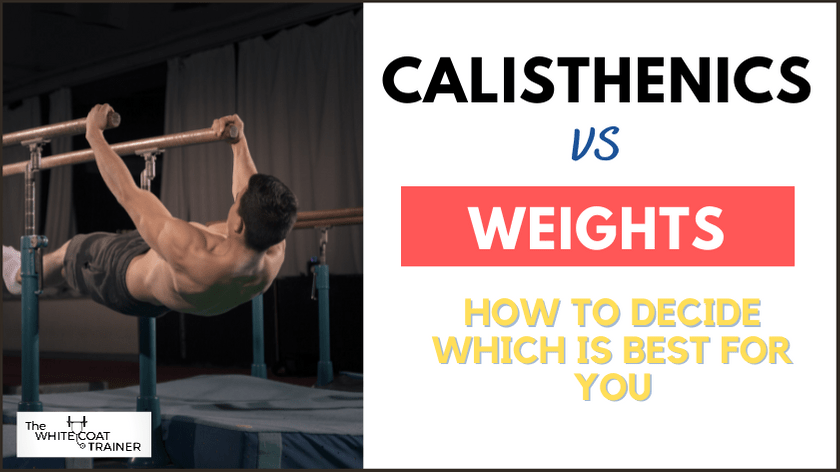
Calisthenics Vs Weights: Which One Should You Pick?
Here is a quick summary of everything you need to know.
You should do calisthenics if:
- You prefer to work out at home, or do not have time to commute to a gym
- You prefer to use a minimal amount of equipment
- You desire functional strength in all basic human movement patterns
- You do not care about developing a lot of lower body muscle mass
- You are an absolute beginner and want to start with the basics
You should do weight training if:
- You have access to a fully stocked gym (squat rack, barbells, dumbbells, plates, bench press)
- You understand how to mimic functional movement patterns using weights
- You are willing to learn how to use proper technique
- You desire to build more muscle mass than what is possible with calisthenics (aka bodybuilding)
- You desire to isolate specific muscles
- You are morbidly obese
You should do both if (preferred method):
- You want to develop a very strong well-rounded body
- You like to add variety to your training
- You have access to a gym, but you also would like to master working out on the go
Okay, let’s go over these points in more detail.
If You’d Rather Watch Than Read- Here’s The Video Version
Calisthenics
Calisthenics is the practice of using your own body weight as a form of resistance for the purposes of exercising. In other words, you are lifting your own body weight instead of dumbbells or barbells.
Almost every major exercise that you can do with weights could also be done with calisthenics.
The Major Benefits of Bodyweight Training
So what are the advantages and disadvantages of training with your body weight versus weights?
Calisthenics provides four major advantages to weight training.
They are:
1) Calisthenics is Free
Besides needing access to some sort of
This means that you don’t need weights, equipment, or a gym membership.
2) Calisthenics Provides A Greater Degree of Freedom
Because calisthenics requires little to no equipment, you can exercise just about whenever or wherever you want.
Your gym is closed? No problem.
You are away and the hotel gym sucks? No problem.
You don’t feel like leaving the house but you still want to work out? No problem.
*The only caveat is that a pull-up bar does become necessary if your goal is to develop a well-rounded body*
3) Calisthenics Will Improve Your Flexibility and Coordination
Calisthenics movements require a decent amount of body awareness, body control, and movement.
Unlike weights, your entire body has to move in unison when you are performing calisthenic exercises.
In addition, some exercises like the lunge or the handstand require a decent amount of mobility in the hips and shoulders.
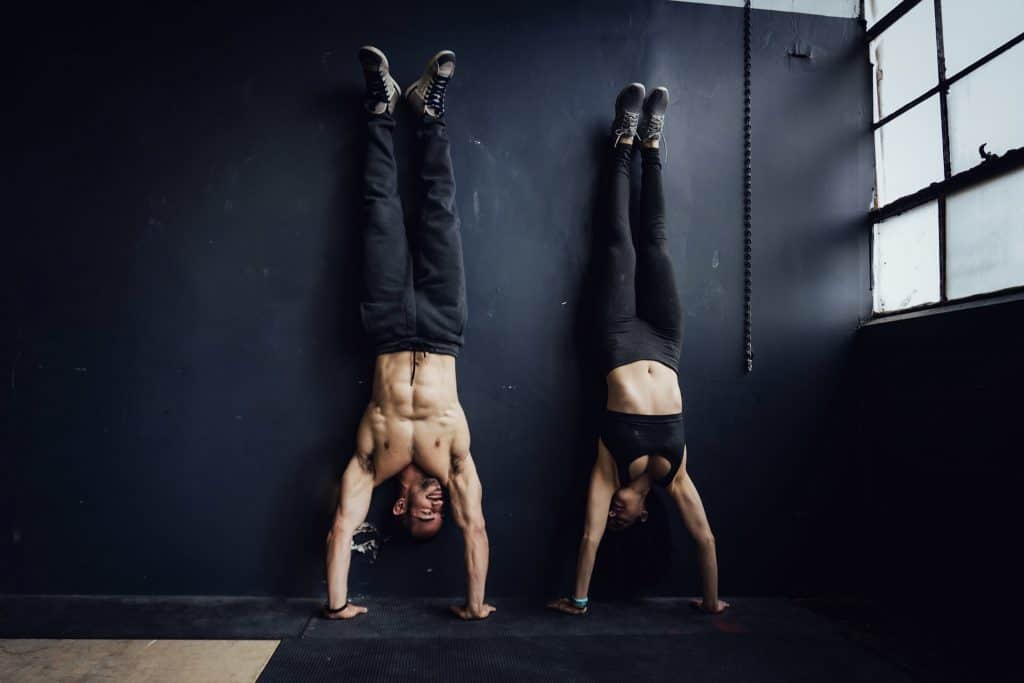
As you get stronger in calisthenics, your mobility and flexibility automatically improve as well.
4) Almost All Calisthenics Exercises Train Your Core
Almost every calisthenic exercise requires you to maintain a neutral or a hollow body position.
This automatically turns on and activates your core muscles as you need to balance yourself while doing bodyweight exercises.
A lot of weight exercises, on the other hand, lock your body into a fixed position, eliminating the stability component inherent in calisthenics.
A lot of calisthenics athletes tend to have a strong core just from the nature of their training.
I go over a few more benefits of calisthenics in 15 Unique Benefits Of Calisthenics [Why You Should Consider doing it].
Disadvantages/ Cons of Calisthenics
While all of that sounds magical, let’s quickly go over the disadvantages of calisthenics.
There aren’t many.
1) Calisthenic Exercises Require An Understanding of Levers
Unless you have a weight vest, you are limited to your own body weight.
As a result, you need to know how to leverage your body weight to increase or decrease the difficulty of each exercise.
For example, changing the angle in which you perform a push-up can drastically change the intensity of the exercise, as does your hand positioning.
It is important that you know how to change the levers appropriately so that the exercise provides you with the right amount of intensity.
Failure to use these levers correctly can also lead to injury.
2) Some Calisthenic Progressions Are Very Difficult
As you get stronger, some exercises are going to become easy.
Sure, it can be fun doing 50 or 100 push-ups in one set, but there comes a point of diminishing returns.
In order to continue moving forward, you will have to increase the intensity of the exercise by performing a new progression or variation.
Oftentimes, the jump in intensity from one progression to the next is huge, which can lead to frustration and demotivation.
For example, handstand push-ups might be a huge jump for you after training pike push-ups.
3) Calisthenic Leg Exercises Are Limited Compared To Upper Body Exercises
The last disadvantage is that you cannot train your legs as good strictly using calisthenics.
Your legs are powerful, and you will quickly be able to progress through a lot of lower body exercises in the calisthenic library.
For example:
Once you master the 1 leg squat (aka the pistol), there isn’t much more intensity you could add to that exercise beyond adding weight to your body.
As a result, your legs will pale in comparison to your upper body if you only use bodyweight exercises.
Speaking of weights, let’s talk about their major benefits.
| Pros | Cons |
|---|---|
| Calisthenics is free | You must understand and know how to use levers |
| Provides a lot of freedom : workout anytime anywhere | Some progressions are very difficult |
| Calisthenics improves your athleticism | Calisthenic leg exercises are very limited |
| Most calisthenic exercises train your core |
Weight Training
Weight training refers to the use of external resistance (rather than your own body weight) to exercise. This can be in the form of
- free weights
- weight machines
- resistance bands
The Advantages of Lifting Weights
Weights do offer some unique advantages over bodyweight training.
They are:
1) Weights Are Easy To Scale
An effective way to scale any weight exercise is to change the amount of weight you are using.
To make any exercise more difficult, all you have to do is add 5 lbs to the barbell or the dumbbell. This is the easiest way to implement progressive overload into your training.
Conversely, if an exercise is too challenging, all you have to do is take some weight off the bar.
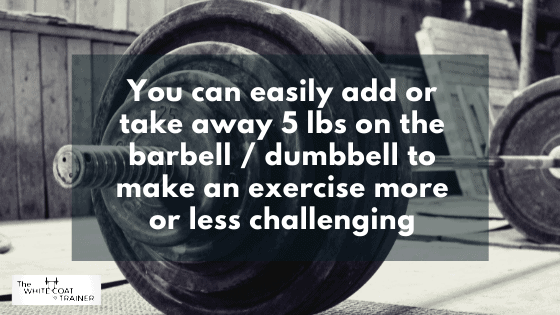
2) Weights Can Help You Develop A Powerful Lower Body
If you want strong, toned, or muscular legs, then you should squat.
If there is only one exercise that you could perform, it would be the squat with added weights.
The second best exercise is the deadlift.
There is no comparison.
The squat and the deadlift are the king and queen of fitness.
3) Weights Allow You To Isolate Individual Muscles
Weights allow you to train one specific muscle group in one specific pattern.
Isolation exercises are beneficial if you have an injury or a muscular imbalance that requires you to train a specific movement pattern.
Calisthenic exercises tend to be compound exercises.
Disadvantages/ Cons of Weight Training
Now let’s go over the disadvantages of weight lifting.
1) Weight Lifting Requires Expensive Equipment
In order to train your body in the manner in which it is meant to be trained, you will need a few things.
- A Barbell
- Dumbbells
- A Bench
- A Squat Rack
- Plates
It is ideal to find a gym that has all of these things. The other option is to purchase all of this equipment if you have the money and space in your home.
2) You Better Make Sure That Your Form Is Adequate
Proper technique during exercise is ABSOLUTELY critical.
If you perform any kind of weight lifting with improper form, you significantly increase your risk of injury.
This is also true with calisthenics, however, you can do A LOT more damage with external weights loaded onto your body.
Especially if you use heavy weights.
Always practice good technique!
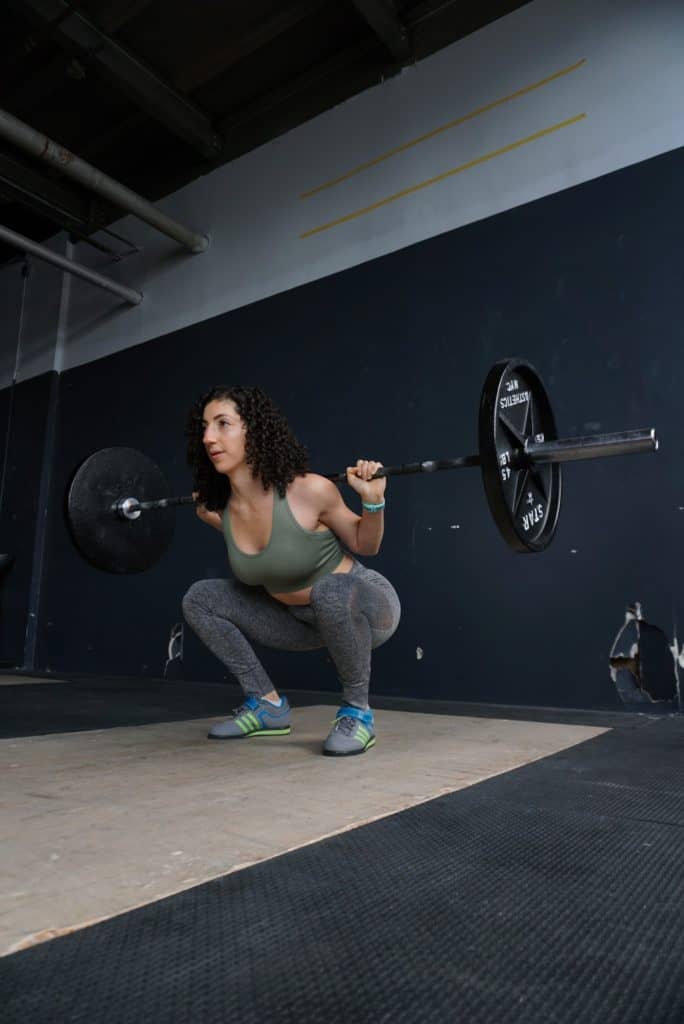
3) Weight Training Requires An Understanding Of Human Movement
You will get the most benefit from weight training when you focus on compound movements.
There are six functional that you should focus on. These include
- The Horizontal Push
- The Horizontal Pull
- The Vertical Push
- The Vertical Pull
- The Hip Hinge
- The Squat
We cover these in greater detail in our post on designing a gym workout.
| Pros | Cons |
|---|---|
| Weights are easy to scale – you can always add 5 lbs to increase the intensity | Weight lifting requires a fully stocked gym and good quality equipment |
| It is easier to build muscle with weights, especially in the lower body | Poor form increases injury risk significantly |
| Weights allow you to isolate specific muscle groups | Many weight exercises are non-functional |
The Final Head to Head Comparison- Calisthenics Vs Weights [8 Tests]
Here are 8 head-to-head comparisons of both styles of resistance training.
Which is better in terms of ease of progression, exercise variety, training flexibility, ease of learning, isolating muscles, functional strength, building muscle and losing weight?
Let’s get started.
1) Ease of Progression:
Which type of training is easier to progress on?
Weight lifting.
It is much easier to add 5 lbs to a barbell than it is to perform a new variation of a calisthenic exercise.
*The one exception is weighted calisthenics, in which you can add 5 lbs to a weight vest.*
2) Variety:
Which type of training provides more variety?
Draw.
If you are the type of person who gets bored easily, weight training can keep you entertained through variety.
There are about 30 different bicep curl variations you can perform, 20 different tricep extension exercises you can do, and hundreds of machines each serving different purposes.
In addition, you can also find 50 different ways to do a push-up or a pull-up.
There are so many different exercises you can do with each. You are only limited by your creativity.
3) Training Flexibility:
Which type of training provides you with more flexibility/freedom?
Calisthenics
With calisthenics, you can workout anytime, anywhere.
With weight training, you need access to a gym, the right equipment, and a lot of space.
4) Ease of Learning:
Which type of training is better suited for a beginner?
Calisthenics
Almost all bodyweight movements can be done with a simple beginner variation. In general, it is easier to handle your own bodyweight than it is to handle an external weight.
With that said, you can perform every weighted exercise with very light resistance as you are learning proper form.
Also, if you are obese, it is much safer to start with weight lifting.
5) Isolating Muscles:
Which type of training is better for isolating specific muscles?
Weight Lifting
Not much to say here. Almost every bodyweight exercise is a compound exercise.
Weights, on the other hand, allow you to specifically target any muscle in the body.
The most common isolation exercise- the bicep curl.
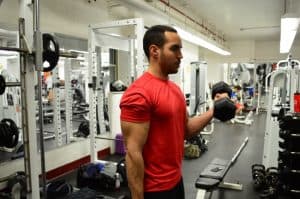
6) Functional Strength:
Which type of training is better for building functional strength?
Calisthenics
When you lift weights, you will get good at lifting weights. Unless you train specifically for weighted functional strength, weights can decrease your mobility and leave you with muscular imbalances.
Calisthenics on the other hand naturally improves flexibility, coordination, and improves your real-world strength.
If you are a complete master of the pull-up or the freestanding handstand, there is very little that you cannot do with your body.
7) Building Muscle:
Which type of training is better for building muscle?
Weight lifting
You will build more overall muscle using weights, especially in your legs.
However, proper training can help build equally impressive amounts of muscle in the upper body using weights or calisthenics.
8) Fat Loss
Which is better for fat loss?
Draw
Calisthenics and weight training can be equally effective for fat loss provided you train correctly for it.
What’s the best way to exercise for weight loss?
High-Intensity Interval Training, or HIIT for short.
You can do HIIT workouts with weights, calisthenics, or both.
So To Sum It Up: You Should Lift Weights & Do Calisthenics!
So we have 5 points for bodyweight training and 5 points for weight lifting. Each has its pros and cons, but if you use them correctly, you can achieve amazing results.
Now that you understand the pros and cons of each, it’s up to you to decide.
Get the best of both worlds and incorporate both forms of strength training into your routine.

Other Frequently Asked Questions
Can You Build Muscle With Only Calisthenics?
It is possible to build muscle with only calisthenics because Your Body Doesn’t Know The Difference Between Resistance!
Whether you are doing an overhead press or a handstand push-up, all your body knows is that it is encountering resistance and it must build muscle to compensate.
Take a look at Austin Dunham, who primarily trains calisthenics, or take a look at high-level gymnasts.
No one would say that these people lack muscle.
You will not, however, be able to build as much lower body muscle as you can with weights.
What Makes You Stronger- Weights Or Calisthenics?
You will likely build stronger muscles with weights, but the strength will be specific to your training.
This is because of the SAID Principle.
It stands for specific adaptation to imposed demands.
In other words, if you want to get stronger at pull-ups, the best way to do it is to train pull-ups. You wouldn’t go for a swim and expect to get better at pull-ups.
So weight training will get you stronger at weight training, and calisthenics will get you stronger in calisthenics, although you may notice a carryover in strength between the two.
What Burns More Calories: Calisthenics Or Weight Lifting?
Both types of training are equally good at burning calories. It all depends on how much volume you decide to do.
Keep in mind that neither type of training will burn a significant number of calories, probably somewhere in the realm of 5-10 calories per minute of work.
Should I Lift Weights Or Do Calisthenics First?
As a beginner, you should do calisthenics first so that you can learn how to do all the major functional exercises while decreasing your risk of injury.
As you become more experienced, you can train both in the same session.
For example:
- Bench Press: 4 sets of 8 repetitions
- Horizontal Pull-ups: 3 sets of 12 repetitions
- Dips: 3 sets of 12 repetitions
- Hollow Body Holds: 3 sets of 30 second holds
This is what I call a calisthenics weight training hybrid.
How To Design Your Strength Training Program With Either Method
Here’s how to make your workout program.
| How To Create A Simple Calisthenics and Weight Training Workout Plan |
|---|
| 1) Choose one exercise from each of the 7 major categories |
| 2) Select 3-4 exercises to perform each day (ideally, they shouldn’t overlap) – For example, don’t train the horizontal and vertical push back to back |
| 3) Create 4 unique workouts, each with a different selection 3 exercises |
| 4) Aim to train each major category 1-2x per week |
| 5) Focus on using different rep ranges every 4-6 weeks. – Reps in the 7-12 range primarily tone and build muscle – Reps in the 3-6 range primarily build strength – Reps >12 primarily build endurance |
| 6) Use progressive overload every week |
| 7) Lastly, do not spend more than 30-45 minutes working out |
So that’s all there is to it.
But we have good news for you.
We have already done all of this work for you.
If you want to tone up, build muscle, or gain strength using weights and calisthenic exercises, check out our strength program for busy professionals.
If you do not want to go to a gym, and you prefer to work out at home only with calisthenics, then check out our home workout program.
Both are comprehensive workout plans that will get you strong and ripped in 15 weeks.
So that’s all that you need to know about calisthenics vs weights.
So which do you prefer?
Next, You Should Read
- Calisthenics For Beginners: Full Guide + Free Workout Plan
- The Complete List of The Best Calisthenics Exercises
- How To Get Toned: The No-Nonsense Guide To Lean Muscle

Alex Robles, MD, CPT / Brittany Robles, MD, MPH, CPT
Alex & Brittany Robles are physicians, NASM Certified Personal Trainers, and founders of The White Coat Trainer: a resource dedicated to improving the health and fitness of busy professionals using time-efficient strategies. Their advice has been featured in My Fitness Pal, Prevention, Livestrong, Reader’s Digest, Bustle, The Active Times, and more. Learn more about them here.
